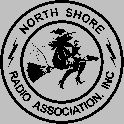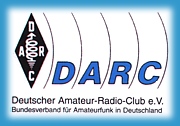Welcome to Michael's ham radio page. My call sign is K1JE. I received my first ham radio license in Germany in 1980, with the call sign DG1NAJ. Of course, I had to give that up when I left Germany in 1988. In the U.S. I had the call sign KE1JE until I upgraded to Extra class. I then shortened it to K1JE.
My daughter Anna also has her ham radio license. She got her call sign K1ALJ at age eight.
After a successful contact, ham radio operators exchange special confirmation cards, called "QSL Cards". Here is my current QSL card, and my old German one.


Shortwave (HF): Depending on propagation (which itself depends on a variety of factors, such as sunspot cycle, time of day, season, frequency, etc.), it is possible to contact fellow hams in just about every country of the world.
For a list of the 300 countries I have contacted since 1998, click here: DXCC Countries Worked List. The American Radio Relay League maintains the official DXCC (DX Century Club) countries list and awards program.
My DX Awards list includes:
DXCC (Mixed, CW, Phone, RTTY, 10m, 15m, 20m, Millennium)
WAC (Worked All Continents, CW, Phone, RTTY)
WAZ (Worked All Zones)
WAE (Worked All Europe, level I)
WAS (Worked All States)
WPX (Prefix Award)
Another great activity is contesting. It's not necessarily about winning the contest, just about having fun spending a weekend making lots of contacts with other hams, reaching as many countries as possible.
RTTY (radioteletype): We used to use old teletype machines that required two strong people to lift and that made a lot of noise during use. Nowadays, this mode uses computers to achieve the same goal: sending text around the world.
PSK31 is the new radioteletype mode that uses phase shift keying instead of the traditional frequency shift keying. Great mode and lots of fun! For more information, look here.
ATV (Amateur Television): This mode has always fascinated me. Fast Scan (FSTV, as opposed to SSTV) is used to transmit regular televison signals. ATV has nothing in common with broadcast television, other than the technology itself. Transmissions are only between hams (although anyone is allowed to watch), and the content is strictly of a non-commercial nature. To receive ATV, all you may need is a decent antenna and a cable-ready TV, tuned to cable channel 60 (439.25 MHz video). Go here for more information on Amateur Television
SSTV (Slow Scan Television): The shortwave version of television. It takes between several seconds to a couple of minutes to transmit a still picture (in full color), and it's a great experience when you can send a picture all the way around the world, and someone else can send their picture back. I'm planning to add some examples here soon.
Satellites and ISS: Yes, hams have their very own satellites and there is ham radio on the International Space Station. I've been able to communicate through various satellites and chatted with hams on the international space station. Visit AMSAT to learn all about amateur satellites
EQUIPMENT
Most of my radio equipment is linked together. For example, the computer can control the shortwave radio by setting the frequencies and keying it for RTTY (radio teletype), CW (morse code) or SSTV. It can also get the frequency and mode from the radio for logging purposes, decode signals through digital signal processing, etc.
Shortwave (HF):
![]() Icom IC-756PRO
transceiver. This is a great radio! The digital filters are unbelievable.
Icom IC-756PRO
transceiver. This is a great radio! The digital filters are unbelievable.
![]() Icom IC-706MkIIG
mobile transceiver. Another great rig. Finally, I have HF in the car
so I can chat with people around the world while I drive. Absolutely amazing
I can reach Australia with the 7 ft antenna mounted on the back of the car.
Icom IC-706MkIIG
mobile transceiver. Another great rig. Finally, I have HF in the car
so I can chat with people around the world while I drive. Absolutely amazing
I can reach Australia with the 7 ft antenna mounted on the back of the car.
![]() Icom IC-745 transceiver. An older rig, it still gets used as
a backup, for demos and for events like Kid's Day.
Icom IC-745 transceiver. An older rig, it still gets used as
a backup, for demos and for events like Kid's Day.
![]() Drake L4B linear amplifier
(1300+ Watts output PEP).
Drake L4B linear amplifier
(1300+ Watts output PEP).
![]() Ten-Tec 1340 QRP transceiver
Ten-Tec 1340 QRP transceiver
![]() Fully automated antenna switching. When I change bands on the
radio, the correct antenna is selected with a bank of relays.
Fully automated antenna switching. When I change bands on the
radio, the correct antenna is selected with a bank of relays.
![]() Heil Proset headset with
boom microphone
Heil Proset headset with
boom microphone
![]() MFJ cross-needle wattmeter and Versa Tuner II
MFJ cross-needle wattmeter and Versa Tuner II
![]() Bencher iambic paddle
Bencher iambic paddle
![]() Bencher YA-1 low pass filter
Bencher YA-1 low pass filter
![]() Grundig Satellit 2100 shortwave
broadcast receiver
Grundig Satellit 2100 shortwave
broadcast receiver
VHF / UHF:
![]() Icom IC-251E, 2m all-mode transceiver (modified for US operation)
Icom IC-251E, 2m all-mode transceiver (modified for US operation)
![]() Icom IC-706MkIIG
mobile transceiver. See above. In addition to all HF bands, this radio
provides all modes on the 2m and 70cm bands.
Icom IC-706MkIIG
mobile transceiver. See above. In addition to all HF bands, this radio
provides all modes on the 2m and 70cm bands.
![]() Yaesu FT-2600M, 2m FM / Packet
transceiver
Yaesu FT-2600M, 2m FM / Packet
transceiver
![]() Yaesu VX-5, 6m / 2m / 70cm FM handheld transceiver. Three bands
at 5 Watts. This radio is smaller than the battery that powers it. This
is the one I take with me when I need a portable radio.
Yaesu VX-5, 6m / 2m / 70cm FM handheld transceiver. Three bands
at 5 Watts. This radio is smaller than the battery that powers it. This
is the one I take with me when I need a portable radio.
![]() Yaesu FT-50, 2m / 70cm FM handheld transceiver. This is now Anna's
radio since she got her license.
Yaesu FT-50, 2m / 70cm FM handheld transceiver. This is now Anna's
radio since she got her license.
![]() Mirage MH-A201 VHF/UHF 50W amplifier
Mirage MH-A201 VHF/UHF 50W amplifier
![]() Advanced Receiver Research preamps for VHF and UHF
Advanced Receiver Research preamps for VHF and UHF
![]() Kantronics KPC 3+ packet
controller
Kantronics KPC 3+ packet
controller
![]() PC Electonics TX70-10 Amateur
Television Transmitter, 70cm and 33cm downconverters
PC Electonics TX70-10 Amateur
Television Transmitter, 70cm and 33cm downconverters
Antennas:
![]() Force-12 C3 multi-monobander
(20m, 17m, 15m, 12m, 10m). Great antenna!
Force-12 C3 multi-monobander
(20m, 17m, 15m, 12m, 10m). Great antenna!
![]() Inverted-Vee's (80m and 40m)
Inverted-Vee's (80m and 40m)
![]() 1/4-wave sloper (30m and 160m)
1/4-wave sloper (30m and 160m)
![]() 4-element yagi (2m)
4-element yagi (2m)
![]() 10-element yagi (70cm)
10-element yagi (70cm)
![]() Rohn 25G tower, Yaesu
G-800SDX rotor
Rohn 25G tower, Yaesu
G-800SDX rotor
![]() Cushcraft A3S tribander
(not on tower) for fieldday operation or portable use.
Cushcraft A3S tribander
(not on tower) for fieldday operation or portable use.
![]() Cushcraft R-7000 multiband vertical (40m thru 10m) for temporary
or portable use
Cushcraft R-7000 multiband vertical (40m thru 10m) for temporary
or portable use
Computer:
![]() Homemade Pentium 4 (with 3 serial ports and 2 parallel ports just for
ham radio, plus 4 USB ports for other stuff). This is a unique, custom tailored
system for my needs.
Homemade Pentium 4 (with 3 serial ports and 2 parallel ports just for
ham radio, plus 4 USB ports for other stuff). This is a unique, custom tailored
system for my needs.
![]() WriteLog contest
logging, includes DVK, RTTY, PSK31, CW keyer
WriteLog contest
logging, includes DVK, RTTY, PSK31, CW keyer
![]() DXbase 2000 general-purpose
logging and tracking
DXbase 2000 general-purpose
logging and tracking
![]() PacTerm packet radio terminal
PacTerm packet radio terminal
![]() Win95SSTV: slow-scan
television software
Win95SSTV: slow-scan
television software
LINKS - LINKS - LINKS - LINKS
Here are some links that may interest you:
![]() American Radio Relay League (ARRL) Anything you
might want to know about ham radio. There is a great overview
for newcomers.
American Radio Relay League (ARRL) Anything you
might want to know about ham radio. There is a great overview
for newcomers.
The
Yankee Clipper Contest Club is a special
purpose amateur radio club devoted to the pursuit of operating and technical
excellence.
![]() AMSAT (Amateur Satellite Corporation)
AMSAT (Amateur Satellite Corporation)
 The
North Shore Radio Assocication is
an Amateur Radio Organization on Boston's North Shore involved in all aspects
of Amateur Radio, and operating several repeaters on the North Shore.
The
North Shore Radio Assocication is
an Amateur Radio Organization on Boston's North Shore involved in all aspects
of Amateur Radio, and operating several repeaters on the North Shore.
The Patriot DX Association is another Amateur Radio Organization on Boston's North Shore, dedicated specifically to DX operation.
ATNA - Amateur Television of North America is dedicated to Amateur Television.
 The German Amateur
Radio Association, DARC (Deutscher Amateur
Radio Club) can be found here. I used to be a member of the Nuernberg-Nord (B25)
local division.
The German Amateur
Radio Association, DARC (Deutscher Amateur
Radio Club) can be found here. I used to be a member of the Nuernberg-Nord (B25)
local division.
 Bavarian Contest
Club - An Amateur Radio DX- and Contest Club in Bavaria (Germany).
Bavarian Contest
Club - An Amateur Radio DX- and Contest Club in Bavaria (Germany).